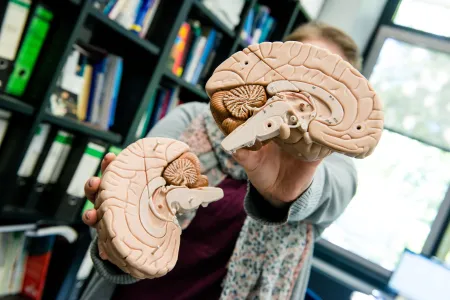Neuroscience
When Serotonin Dims the Light
A serotonin specific receptor can determine how important visual stimuli are perceived. This explains the effects of certain drugs and could help in understanding psychiatric diseases.
Signals in our brain are not always processed in the same way: Certain receptors modulate these mechanisms, influencing our mood, perception, and behavior in various ways. One of these is the 5-HT2A receptor, which has a recently discovered unique characteristic: It dampens incoming visual information, giving our brain more space for internal processes and interpretations. This discovery by a research team from Ruhr University Bochum, Germany, could also help explain the effects of drugs like LSD. When this receptor is overactivated, external sensory input is suppressed, and the brain generates more internally-driven images. “It’s a bit like our brain is increasingly talking to itself,” explains Professor Dirk Jancke. The findings, published in the journal Nature Communications on September, 14, 2024, provide new insights into our understanding of perception and psychiatric disorders.
In the jungle of serotonin receptors
Receptors mediate the transmission of information between nerve cells. The release of serotonin alters nerve cell activities throughout the brain. At least 14 types of serotonergic receptors can be distinguished. "The situation is particularly tricky because these receptors can be both inhibitory and activating," says Dirk Jancke. “Additionally, they are expressed in different cell types, which in turn have mutual inhibitory or excitatory effects on the entire network.”
Using light against the darkness in the brain
Investigating the effects of receptors in the brain is therefore not a simple task. Conventional pharmacological methods for elucidating the function of receptors upon the neural network are limited. They are usually not specific enough and, crucially, operate on a slower timescale. The research group led by Professor Stefan Herlitze has therefore developed alternative methods. Light-sensitive receptor proteins are introduced into nerve cells using viruses. The light-sensitive receptor proteins are genetically modified, such that they can mimic the functions of a selected receptor type. This allows the selected receptor type to be turned on and off like a light switch, precisely and within milliseconds. For this purpose, ultra-thin optical fibers are implanted in mice, delivering light of the desired wavelength to the appropriate brain region via LED control.
5-HT2A receptors regulate sensitivity to sensory input
Through this method, the researchers discovered that the 5-HT2A receptor selectively suppresses the strength of incoming visual information. “Surprisingly, this happens without inhibiting other parallel processes,” reports Dr. Ruxandra Barzan, the study’s lead author. Thus, the brain reduces the importance of current sensory input in favor of internal communication and interpretation processes. “This means that we’ve discovered a mechanism that regulates how much importance is attached to incoming information,” says Ruxandra Barzan.
Understanding hallucinations, developing therapeutic approaches
Hallucinations induced by drugs like LSD could therefore be interpreted as a form of self-dialogue, according to Dirk Jancke. “Through overactivation, the 5-HT2A receptor suppresses external sensory-driven activity, and the brain creates perception independent of external stimuli.”
In a healthy brain, serotonin activates different receptor types simultaneously, which ensures that the flow of information is weighted in a balanced way. In case of psychiatric diseases, this balance can be disrupted. The researchers hope that their recent findings could contribute to the development of new therapies in which specifically selected receptors are activated in low doses in order to restore such balance. Psychedelic drugs that selectively target the 5-HT2A receptor, for example, could be used for therapeutic purposes under medical supervision and in defined learning contexts in order to compensate for abnormal imbalances in receptor activation in the long term.
Artificial Intelligence meets neurobiology
To better understand the complex interactions between different cell types and receptors in the brain, the researchers used computer models that simplify key features of neural circuits. They tested the hypothesis that the receptor only shows the observed effects when it is activated simultaneously in both inhibitory and excitatory nerve cells. This hypothesis was supported by their model. The research group led by Professor Sen Cheng found in their simulations that only the simultaneous receptor activation in inhibitory and excitatory cells leads to network interactions that replicate the experimental findings.


